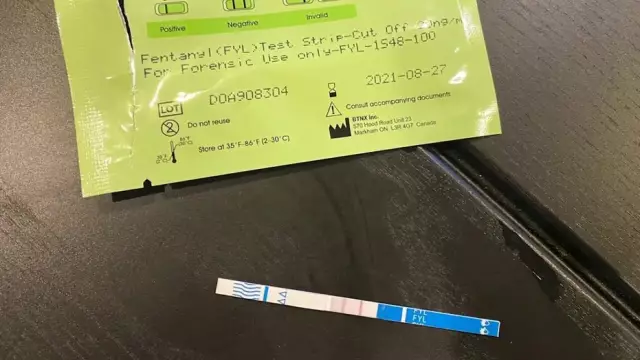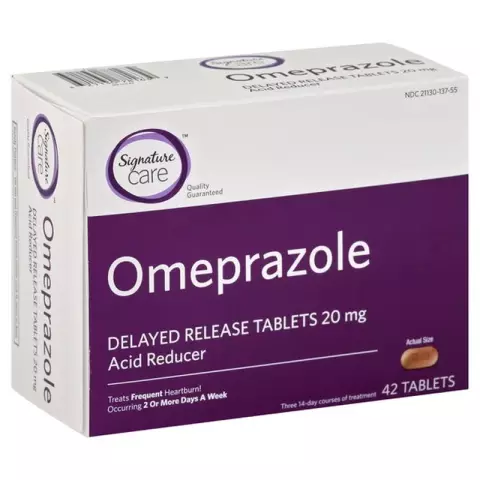- Author Rachel Wainwright [email protected].
- Public 2023-12-15 07:39.
- Last modified 2025-11-02 20:14.
Fentanyl
Instructions for use:
- 1. Pharmacological action
- 2. Indications
- 3. Contraindications
- 4. Side effects
- 5. Overdose
- 6. Method of application
- 7. Special instructions
- 8. Release form
- 9. Storage conditions

Fentanyl is a drug belonging to the group of opioid analgesics.
Pharmacological action of Fentanyl
Fentanyl is a synthetic analgesic with short-term and rapid analgesic and sedative effects. By its analgesic ability, it is many times superior to Morphine.
The drug has a depressing effect on the vasomotor and respiratory centers. Stimulates the vomiting center, as well as the centers of the vagus nerve. Fentanyl increases the tone of the sphincters of the urinary and gallbladder. Reduces renal blood flow, intestinal motility and blood pressure. Promotes the onset of physiological sleep, euphoria.
The rate of development of tolerance and drug dependence to the analgesic effect of Fentanyl is characterized by significant individual differences.
The drug is significantly less likely to cause histamine reactions than other opioid analgesics.
In the instructions for Fentanyl, it is noted that the maximum analgesic effect with intravenous administration of the drug is noted after 3 minutes, and with intramuscular administration - after half an hour. The duration of its action with intravenous administration is one hour, with intramuscular administration - 2 hours, and when using a transdermal therapeutic system (TTS) - up to 72 hours.
Indications
Fentanyl injections are used:
- For relief of pain syndrome (postoperative pain, trauma, in cancer patients, myocardial infarction);
- For premedication;
- For neuroleptanalgesia.
The release form of Fentanyl in the form of a transdermal therapeutic system (TTS) is intended for the treatment of chronic pain syndrome caused by oncological pathology and some other diseases (Varicella zoster infection, neuropathy, etc.).
Contraindications
- Depression of the respiratory center;
- Hypersensitivity;
- Bronchial asthma;
- Pregnancy and lactation;
- Obstetric operations;
- Cranial hypertension;
- Addiction.
Side effects of Fentanyl
According to the instructions, Fentanyl can lead to the development of side effects from various systems:
- Respiratory system - respiratory depression until it stops;
- Central nervous system and sensory organs - drowsiness, headache, blurred vision, euphoria, increased intracranial pressure;
- Digestive system - nausea, vomiting, constipation, biliary colic;
- Cardiovascular system - lowering blood pressure, bradycardia up to cardiac arrest;
- Urinary system - acute urinary retention;
- Allergic reactions - itching, chills, laryngospasm, bronchospasm.
The release form of Fentanyl in the form of a patch can lead to a burning sensation, itching, redness of the skin at the site of application. These phenomena disappear within a day after the removal of the patch.
Taking Fentanyl can lead to the development of drug dependence.
Fentanyl overdose

Overdose of this drug requires emergency medical attention. The specific antidote for Fentanyl is Naloxone. Supportive and symptomatic therapy is carried out (transfer to mechanical ventilation, administration of Atropine sulfate, replenishment of the BCC).
How to use Fentanyl
According to the instructions for Fentanyl, depending on the clinical situation, intravenous or intramuscular administration of the drug is prescribed at a dose of 2.5 to 150 μg per kg of the patient's body weight. The intervals between injections are determined by the doctor individually.
When using TTS, the dose depends on the patient's condition, as well as the effectiveness of this treatment method.
special instructions
According to the instructions, Fentanyl should only be used by medical personnel who are ready to carry out resuscitation measures if necessary.
When using the patch, you should avoid sunbathing, visits to saunas.
During treatment, patients are prohibited from doing work that requires high concentration of attention and quick response.
It is forbidden to carry out neuroleptanalgesia in the absence of the necessary equipment for artificial lung ventilation.
Release form
Fentanyl for injection is available in the form of a 0.005% solution in ampoules of 2.0 and 5.0 ml.
Fentanyl is also part of the TTS, which looks like a patch with a special membrane that regulates the rate of release of the active substance.
Storage conditions
Fentanyl belongs to list A and must be stored according to the rules established for the storage of narcotic drugs.
Information about the drug is generalized, provided for informational purposes only and does not replace the official instructions. Self-medication is hazardous to health!






